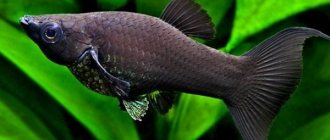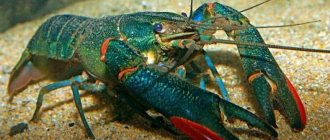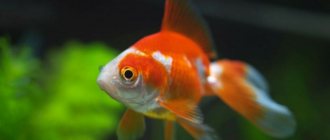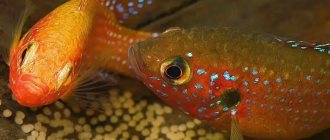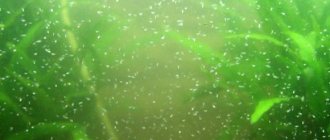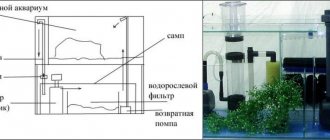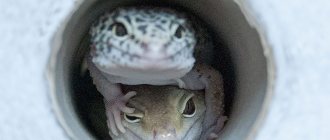Goldfish
Reproduction of goldfish is an interesting and at the same time very labor-intensive process. Which requires the aquarist to have a certain level of skills and knowledge. Goldfish are one of the most common aquarium fish species. Today, this type of aquarium fish can be purchased at almost any pet store. However, in the recent past, namely at the end of the 19th century, only rich and noble people could boast of an aquarium with such inhabitants.
Goldfish first appeared in Europe in the 17th century. It is believed that this type of aquarium fish was originally actively bred in China. There are many types of goldfish, which have different shapes of their bodies, as well as the length of their fins, bodies, and also have different color scales.
Types of goldfish - comet, redcap and telescope (from left to right).
Conditions for keeping goldfish
In order for fish to reproduce successfully in an aquarium, it is necessary to create favorable conditions. Since this is not a viviparous species, you should select a tank for spawning and equip it with good aeration, powerful filtration, and lighting. Safe decorations and plants will create a private environment for the fish.
The water temperature of the spawning tank should not exceed 28°C. It is believed that the optimal temperature parameters depend on the body length of the goldfish:
- types of elongated shape - 15–25°C;
- short-bodied breeds - 22–28°C.
Attention!
It is important to avoid sudden changes in temperature.
Goldfish are one of the oldest aquarium fish.
Other maintenance patterns include seasonal changes. In summer, the water temperature in the spawning area can be several degrees higher than the minimum values, and in winter lower.
It is recommended to add table salt to the water, a concentration of 5–10%. Fish are not demanding on chemical parameters. The optimal values do not differ from those recommended for main maintenance outside the spawning period.
| Acidity, in, pH | 6.0 – 8.0 units |
| Hardness, in dGH | 8 – 25 units. |
Water renewal (1/3 of the volume) is carried out weekly. The bottom is siphoned and the filter is cleaned first. Water is poured with settled water (1–2 days) or running water, but purified with special reagents (Tetra AquaSafe, AQUAYER AntiToxin Vita, etc.).
You can improve the interior space of the aquarium with the help of driftwood, decorations, artificial and live plants. The female can attach eggs to aquaculture. For these purposes, place in the tank:
- Anubias;
- Elodea;
- fern;
- fontinalis;
- pinnate;
- hornwort.
At the bottom of the aquarium, soil is not needed for spawning, so bush species of aquatic crops are planted in pots and then lowered into the water. Filamentous plants that do not require rooting can simply float in the water column or on its surface as a shelter.
Living plants are replaced with artificial substrate:
- nylon washcloths or threads;
- rubber sponges;
- boiled sponge.
The spawning aquarium must be provided with good lighting. The best option: fluorescent or LED lamps. They do not heat the water, provide a lot of light and are less energy intensive. In a spawning tank without soil, eggs die less and are better preserved.
How to properly care
Goldfish do not require any special care. Therefore, during keeping and breeding, they are cared for in almost the same way as other inhabitants of the aquarium. Caring for goldfish involves:
- Perform daily partial water changes in the aquarium. It is best to use settled water that is used for replacement. The volume of water replacement depends on the density of fish in the aquarium. If the density of the aquarium inhabitants is moderate, then in this case it is recommended to drain and change up to 1/3 of the water from the total volume of the tank. If the population density of the aquarium is high, 1⁄2 of the total volume of water in the tank must be replaced.
- Carrying out periodic cleaning of filters , as well as removing accumulated dirt and sand.
- Cleaning the aquarium glass from accumulated plaque.
- Proper feeding.
To successfully breed and raise fish at home, it is necessary not only to properly care for them, but also to carefully monitor their diet. It is best to feed them no more than 2 times a day. Golden fish are omnivores, so it is recommended to use food of not only animal, but also plant origin to feed them.
On the shelves of pet stores there are many options for balanced dry mixtures for feeding goldfish.
It is not recommended to overfeed fish. The food in the container with the fish should be supplied in doses. That is, the amount of food used should be such that the fish can eat it within 15 minutes. Excess food that has sunk to the bottom of the container must be removed. If fish are given food in large quantities, they will become obese, which will lead to infertility and the appearance of various diseases.
Determination of sex and isolation of pairs for reproduction
Young individuals are able to spawn already in the first year of life. However, it is better to breed goldfish with more mature pairs. They reach full development at 2–3 years. It is at this age, during the spawning period, that one can accurately determine the gender of a flock:
- The male has white tubercles on the gill covers, and the edges of the pectoral fins form a sawtooth edge.
- The female may also exhibit such signs, but she is distinguished by her body shape. The abdomen becomes asymmetrically rounded as the eggs mature, and the body becomes curved.
Behavioral characteristics of males are the pursuit of females. Representatives of the fairer sex are always indifferent and do not show any activity.
Several fish are taken into the spawning grounds at once - one female and 2-3 males, so that they are sure to give birth to offspring. It is recommended to isolate breeders in the early evening for better adaptation.
Sex differences
During sexual activity, males develop a white rash (like white tubercles or pimples) on the gill covers and a “saw” on the first ray of the anterior pair of pectoral fins in the form of a series of notches. Males begin to actively swim after females, staying near their ovipositor. A few days before spawning, the males begin to chase the female; The activity of males gradually increases and on the day of spawning it reaches a violent pursuit, interrupted by short periods of rest.
The female, mature and ready for marking, has a thick belly filled with eggs. If you look at it from above, you will notice the curvature of the fish’s body caused by the presence of caviar. The resulting curvature often remains after spawning. The anus enlarges and becomes convex.
The rest of the time it is very difficult to identify the gender of goldfish. The only thing is that females look a little fuller than males.
Imitation of spring conditions and selection of pairs
In artificial conditions, fish are able to reproduce all year round; in nature, the spawning period begins in the spring. This time of year can be simulated by gradual changes in water temperature.
Stages of simulating spring conditions:
- Gradually lower the water temperature to 10–12°C in the main aquarium.
- The cooling process is stopped and the water is allowed to warm up under natural room conditions to 18°C.
- The fish are transplanted into a spawning tank with the same water temperature - 18°C.
- Every day, the water temperature in the spawning tank is increased by a couple of degrees until the required parameters are reached in accordance with the time of year.
Before placing goldfish for spawning, suitable individuals should be selected for productive mating.
The main requirements for producers are full compliance of the species with breed standards. If this indicator does not matter, choose males who are most active in relation to the opposite sex. Large females are preferred. Its left side of the body should have a protrusion, and the anal fin area should become noticeably thicker. When a fish is pregnant, it becomes inert and moves heavily.
Manufacturers
In July-August, a year before the future spawning, they begin to think through it, selecting spawners with desirable properties and well-defined sexual differences. Breeders must reach sexual maturity, be healthy, vibrant and active.
July and August are the best time to buy fish as this is the time when breeders sell the surplus. It is advisable to buy six or more young fish at a reasonable price and raise them for the future. This also gives a good chance of getting both sexes of the same origin. The minimum number of adult fish of the same origin is two females and three males, in case of loss of fish.
The next step is to fatten up the fish so they have enough body weight and remain strong enough to prepare to spawn in early spring. They are fed abundantly, mainly with live food: bloodworms, earthworms, large daphnia.
If goldfish are kept in a pond, you will notice that in late October and early November they become less active and do not consume as much food as before. At this time, disease prevention can be carried out like quarantine. And over the next two or two and a half months, the fish should not receive virtually any food. You can give some live food (for example daphnia). If live food is not available, it can be replaced with a branded food with a high level of protein (some companies produce specialized food for the winter). At this time, you need to carefully monitor the fish.
Six weeks before the expected spawning, the temperature is increased to 18°C. At this time, the fish will begin to look for food: start feeding small portions of food with a high amount of protein, increasing the amount of food given along with temperature increases. Good aeration and removal of excess food is necessary.
For spawning, 1 female and 2-3 males are planted. Females should have a prominent left side of the body and a thick rear end. Try to press a little with your fingers near the anus - the body should be very soft. Males are selected with a noticeable white rash on their gills and pectoral fins and should be very active towards females.
Breeding process
After the pair is isolated, spawning begins a few days later, at dawn. Lasts up to approximately 6 hours. In the spawning area, the male’s activity increases. During the courtship period, he begins to make frequent blows with his snout to the area of the female's anus. This is a distinctive sign of how to understand that the female is preparing to spawn.
The male, with rapid movements, tries to drive the female into a corner. When he succeeds, the pregnant goldfish begins to spawn eggs. Males immediately water the eggs with seed for fertilization. The female lays 10–20 eggs at a time. The cycle is repeated and lasts from 2 to 3 hours. Immediately after this, the producers are removed from the spawning area.
When breeding, the eggs fall to the bottom or stick to plant leaves and decorations. Its diameter is 1.5 mm and on the first day it is amber in color. On days 2–3, the eggs become more difficult to distinguish in water, as they lighten and become translucent. Unfertilized eggs turn white on the second day and can quickly become overgrown with fungus. In this case, the eggs can be carefully collected and removed from the spawning tank.
Attention!
The larger the female, the more eggs she can lay.
Spawning occurs gradually
Caviar care
Immediately after fertilization, the eggs are orange in color, which gradually discolors.
Caring for eggs throughout the entire time before hatching is as follows:
- maintain the water temperature at +15 °C;
- It is strictly forbidden to change water;
- the caviar is treated with a solution of methylene blue (1 ml is diluted in 50 liters of water and left for 3 hours).
Important! The day after spawning, it is necessary to remove the unfertilized eggs, which at this time are painted white and have a small fungal fluff.
Method of artificial fertilization of eggs
It is not always possible for the male to naturally fertilize the eggs. In this case, the fish is transplanted into a small tank, carefully taken into the hand and the area of the genitourinary opening is stimulated with a slight movement of the finger. This effect lasts about 30 seconds and allows the sperm to be released.
It is better to carry out the manipulation in close contact with water so that the biomaterial immediately ends up in the tank. The resulting sperm along with water is poured into a spawning tank with spawned eggs. To distribute the biomaterial evenly, stir the water and wait for the larvae to appear.
If goldfish do not spawn, reproduction is stimulated by a pituitary injection into the upper part of the body.
| Acetonated pituitary gland, amount of dry matter, mg | ||
| Weight of fish, in g. | Males | Females |
| 30-50 | 0,3 | 0,1 |
| 50-80 | 0,4 | 0,2 |
| 80-110 | 0,5 | 0,3 |
| 110-149 | 0,6 | 0,4 |
| 140-170 | 0,7 | 0,5 |
Biomaterial is taken from individuals artificially. The female is taken out of the water, the body is wiped with gauze so that the eggs are dry and free of moisture. With light stroking movements along the abdomen, the caviar begins to flow out in a trickle. It is collected in a clean, dry container. The male is also wiped and moisture is removed from the surface of the body. The sperm is collected with an eye pipette, stroking the fish on the sides (direction - from the head to the caudal fin).
The resulting seed is applied to the eggs in drops. It has a liquid consistency and spreads well with the help of a small feather. One drop of sperm can fertilize 5–10 g of eggs.
Inseminated eggs:
- Fill with water (so that it slightly covers the biomaterial), mix with a feather.
- After 2–3 minutes, drain ¾ of the liquid volume, add fresh water, and mix.
- Evenly distributed in the spawning tank.
Placing the eggs separately from each other reduces the chance of fry hatching.
In case of unsuccessful spawning, you can fertilize the eggs manually
Very expensive mutants
In the breeding of silver crucian carp, two branches can be distinguished: short-bodied and long-bodied forms. The first ones look more impressive. Several hundred variations have now been developed. Among the well-known ones: comet, oranda, red cap, telescope, veiltail, lionhead, they are found quite often. But there are also very expensive individuals. The Shubunkin with a blue body tone and black and orange spots scattered throughout it is very valuable. A variety of ranchu called “Batik” looks unusual. All the nuances of color can be better seen in the photo of this goldfish. The tiger captivates with its color and transparent, speckled fins. Manufacturers in Thailand have some of the most expensive ones: orandas, riukins, pearls, panda telescope.
Feeding the fry
The spawning tank with eggs is constantly aerated and intensively illuminated. The water temperature is maintained between 22–25°C. The larvae begin to hatch on days 2–5 and look like strings with eyes. During the first 2–3 days they move in jerks and attach to plants in an upright position. At this moment, they are practically immobilized and feed on the contents of the yolk sac.
After three days, the larvae are already able to reach the surface of the water. Having filled the swim bladder with air, take a horizontal position. This makes it possible to move and eat freely.
Larvae and fry are fed intensively, every 3–4 hours, the diet is selected taking into account age.
| 1 Week | 2 week | 1 month | 2 month |
| ciliates | nematodes | small bloodworm | small bloodworm |
| rotifer | juvenile daphnia | adult daphnia | chopped enchytraeus |
| juvenile cyclops | adult cyclops | Drosophila | |
| dry food Sera Micron, TetraMin | aulophorus |
From 2 weeks you can add yolk to the diet. It is hard-boiled, crushed in water, wrapped in gauze and hung in a spawning tank.
After a month, the frequency of feeding is reduced to 2 times a day. The fry should not experience an excess or lack of food. Residues of feed and waste products must be removed regularly and the water changed frequently.
The fry are kept in the spawning tank for up to 2 weeks. After this, they are transplanted into a 30-40 liter aquarium. This tank volume is designed for 250 fry.
Goldfish fry quickly become like their parents
Breeding goldfish can present many surprises to the aquarist who seeks to produce “pure breed” offspring. Even careful selection of producers does not guarantee that the fry will exactly inherit the standards of their parents. If the hobbyist is not afraid of possible genetic defects in the brood, breeding goldfish will be a labor-intensive but exciting process.
Was this information useful to you? Share in the comments!
How to choose the right aquarium
You should always remember that the size of the inhabitants of the aquarium directly affects the volume of the vessel selected for them. In addition, the size of the aquarium fish affects the number of pets that can be kept in one container.
Breeding goldfish at home involves purchasing a large container for this purpose. This is due to the fact that fish, during their life, constantly emit large amounts of harmful waste products and waste. In turn, the concentration of fish waste in large quantities of water does not harm their health.
When selecting a spawning tank for goldfish, you must use the following formula: for every 2.5 centimeters of the length of the fish’s body, you must spend at least 15 liters of water. That is, for 3 fish, whose body length is from 5 to 7 centimeters, you need a container with a volume of at least 120 liters.
A classic rectangular aquarium is well suited for keeping. and for breeding goldfish.
Swordtail aquarium fish: maintenance, compatibility, reproduction, photo-video review
Compatibility of Swordtails
Popular video with swordfish
Beautiful photos of swordtails
fanfishka.ru>
Lifespan of swordtails
Care requirements and conditions for keeping swordtails
Feeding and diet of swordtails
Varieties of aquarium swordtails
Reproduction and breeding of swordtails
The photo shows a male and female swordtail
Photos of juveniles, fry of swordtails
Diseases and treatment of swordtails
It will not be an exaggeration to say that goldfish have won the hearts of admirers not only with the whimsical shapes of their bodies and fins, huge eyes or intricate growths on the head, but also with their exceptional unpretentiousness and endurance, the ability to survive in conditions in which any other fish would have died long ago. However, at present, many, and not without reason, classify goldfish in another category - “problem fish”. Statistics are an inexorable thing, and according to it, goldfish are now one of the most susceptible to all kinds of diseases, often leading to death. What happened? Let's go back a quarter of a century. Moscow, Bird market on Kalitnikovskaya. Saturday. The sellers' screens display velvet-black telescopes and veiled tails with caudal fins literally trailing along the bottom; orandas with “caps” pulled over their heads... Prices are generally from 30 kopecks to 50 rubles. Locally bred fish, the pride of amateurs and professionals. And again in our time. Moscow, Bird Market, now in Kapotnya. Saturday. Many bright, all possible breeds and colors of goldfish. Any size. Orandas, ranchu, pom-poms, telescopes, water eyes, riukins, comets - for the most demanding choice. Prices range from 20 rubles to a thousand, or even more than one. All the same? No, not the same. Let's take a closer look at the fish. Red ulcer. Half-rotten fin. More, more... Sunken belly. And here is the corpse already... Let's move on. These seem to be “clean”. We ask the seller where the fish is from. China... What's the matter? Where are our breeders? In the end, we find it. Light orange goldfish with a forked tail, vaguely reminiscent of veiltails, black telescopes, occasionally comets... Everything! And again China, Malaysia, again China... And if you want something “your own, dear”? Well, there are three options left: buy what you have, somehow look for more breeders, or... Or try to raise the fish yourself.Of course, the process of raising fry is not as simple as it might seem from the outside. However, given the right conditions, and most importantly, desire, perseverance and patience, even a novice aquarist is quite capable of “raising” a fry.
1. Selection of manufacturers
The first thing an aquarist who aims to get fry should take care of is the selection of producers. This must be approached very, very responsibly: after all, the quality of the offspring directly depends on the quality of the producers. If there are already manufacturers, this simplifies the task. And if not, then you will have to look for them. And this is where China, or rather the abundance of imported Asian fish, can really help. Unless, of course, this fish is poisoned with antibiotics, is not sterile and is not stressed to death by being kept, for example, in a pet store. There are good results when trying to spawn fish “from the wheels”, especially in the winter-spring period. But the specifics of keeping such fish and its condition impose additional conditions, for example, strict hygiene in the home aquarium, strict quarantine, and in most cases active, that is, with the use of medications. We will not consider the desire to get “anything” here, so the first criterion for searching for producers will be compliance with the standards of this particular breed. Considering that in our market it is sometimes very difficult to find truly high-quality specimens, you must remember that there is no need to rush under any circumstances. It is better to be guided by the principle “Measure twice, cut once.” It is very desirable that the fish be approximately the same size, match each other in color, size and shape of fins, and development of breed characteristics. The second criterion is the age of the fish. It is known that goldfish become sexually mature at the age of about a year. That is, offspring can already be obtained from one-year-old parents. But it has long been believed that fish older than two years old produce better offspring. Finding such manufacturers, of course, is quite problematic, but still such a possibility exists. As a result, we determine that the body length of the purchased fish must be at least 8 cm, which corresponds to one to one and a half years of age. Third question: the number of fish purchased. Of course, just one pair, male and female, may be enough for spawning. But there is a possibility that one of the producers will be infertile or some other problem will arise. Therefore, you can purchase fish with some “reserve”, say 4-5 males and 2-3 females. Under normal conditions, it is quite difficult to distinguish a male from a female, but it is possible. Upon careful examination, especially for dark-colored varieties, it is quite possible to discern the sexual characteristics of a male: on the anterior rays of the pectoral fins, males have small white serrations, visible even to the naked eye. And, of course, you need to remember the basic rules that are recommended to be followed when buying fish. So, you should not buy fish from a commercial aquarium: - If at least one fish has hemorrhages on the body, red or black ulcers, swelling and boils. — If at least one fish is unnaturally emaciated, a sunken belly or deformation of the body (skeleton) is observed. - If at least one fish has a “semolina” rash, a white or bluish coating of mucus or a gray-golden “velvet” coating. - If the fish constantly greedily swallows air from the surface of the water, it either lies on the bottom, or “stands with its nose buried in the corner of the aquarium.” - If at least one fish has obvious damage to the fins, coupled with a bluish-white clouding of their edges. — If at least one fish has bulging eyes, an unnatural bloating of the abdomen and (or) protruding scales. You cannot take fish from such aquariums, even if it (still!!) looks healthy. Suspicion should also be aroused by fish with pressed fins, a lowered caudal fin (except for long-veiled forms), and behaving apathetically. A healthy and not stressed fish always swims smoothly and actively, the dorsal fin is raised, the other fins are straightened. The skin is clean, the scales fit tightly to the body, and there is no copious mucus secretion. Keeping goldfish in an aquarium is a separate topic, which is described in sufficient detail, although it is highly controversial. However, I will not dwell on it.
2. Spawning
Under normal conditions, the spawning period for goldfish is from March to June. However, it has been noted that fish can exhibit spawning activity at other times, depending on certain factors. Such factors may be: a steady increase in water temperature compared to usual; a large amount of fresh water (for example, in the case of a massive water change); transportation of fish ready for spawning. This is precisely what can explain the fact that goldfish often begin to spawn literally a few hours after being transplanted into a quarantine aquarium from a shipping bag. In fish ready for spawning, sex differences can be clearly identified: small white grains (tubercles) appear on the gill covers of the male, which, as a rule, persist for two to three weeks and then disappear. True, in large adult males these tubercles may persist longer, or even not disappear at all. Since goldfish eat their own eggs, the spawning aquarium must be prepared accordingly. In particular, the bottom can be lined with plants such as Java moss or hornwort, to which the eggs can stick, after which these plants with eggs will need to be removed. You can also use available artificial materials, such as plastic household washcloths, etc. The main thing is to isolate the caviar from the producers in a timely manner. For spawning, it is best to prepare the producers so that there are 2 - 3 males per female: this will give a higher percentage of fertilized eggs. If this is not possible, you can get by with one male-female pair. The spawning aquarium should be as spacious and low as possible. Temperature and other water parameters should not differ from those in a general aquarium. Spawning, as a rule, begins in the morning, just before sunrise or with its first rays. A sign of spawning activity is the male’s energetic pursuit of the female, accompanied by frequent blows of the male’s head in the area of the female’s anus. Over time, such “courtship” becomes more and more persistent, the male tries to “fix” the female in the corner of the aquarium or in the thick of plants, and, in the end, the female lays a portion of eggs (about 15-20 eggs), which the male immediately fertilizes. The process is then repeated several more times. During spawning, an adult large female is capable of laying from several hundred to 2–3 thousand eggs; younger and smaller females are several times smaller. Spawning activity of fish lasts on average several hours, then the fish calm down and their behavior ceases to differ from usual. During spawning, the spawners must be carefully monitored and removed in time (or the eggs collected in time) so that the eggs are not eaten. All the “wisdom” of natural spawning can be avoided if you use artificial insemination of eggs. This method will come in handy primarily for those who primarily need fry and do not want to wait several months for natural spawning. And it’s not a fact that the fish will survive until this time, given the quality of the fish supplied to our country. The undoubted advantages of this method are, firstly, that the percentage of fertilized eggs is significantly higher, secondly, the producers are a priori isolated from the eggs and will not be able to feast on them, and thirdly, the stress of the fish during the procedure described below may not be greater than during the spawning rut. It should be remembered that the artificial spawning method can only be used for fish ready for spawning; at other times this procedure is useless and may even be dangerous. But in this case, imported fish again comes to the rescue. The fact is that at our quarantine bases it is not difficult to find sexually mature goldfish. Moreover, during overexposure they spawn very often, and more than once, which I myself witnessed. They are kept there, as a rule, at a temperature of 14 to 18 degrees, and when planted in a home aquarium (few people can boast of keeping the water at this temperature at home), spawning activity “wakes up” with a very high probability. And for fish “from wheels” spawning is even more likely. Several times I noticed that fish began to spawn 2-3 hours after unpacking and landing in quarantine. So, what is the essence of the artificial insemination method? To put it simply, in the expression of caviar and milk from producers. To do this, you need to prepare a small container (even a large bowl or small basin, a plastic container for food, etc. will do), into which you need to pour a layer of water about 5-10 cm, or less. It is preferable to take water from an aquarium or settled water, but not from a quarantine aquarium where fish from wheels are kept. For manufacturers, it is also advisable to prepare a separate container, even a bucket or basin, in order to facilitate “access” to them: the procedure discussed below is recommended to be carried out repeatedly with breaks for half an hour to an hour. Let's start pumping with the male. To do this, you need to take the fish in your hand with the belly facing out (many people recommend wrapping it in a wet rag, but I didn’t do this) and with smooth massaging movements from the head to the anus, run your finger along the belly. A viscous whitish mass will begin to flow out of the anus - this is milk. After this, the fish must be “rinsed” in the caviar vessel and planted back.
Expressing milk from a male. Photo by the author
We do the same with the female. Already during the first pumping, a female ready for spawning can release a fairly large amount of eggs. While the female’s eggs and the male’s milk should come out more or less freely when expressing, one should not put too much pressure on the abdomen. If eggs or milt do not come out, this most likely means that either the fish is not ready to spawn, or it has recently participated in spawning.
Expressing eggs from a female. Photo by the author
Freshly spawned goldfish eggs have a yellowish tint and are about 1 mm in size. Over time, unfertilized eggs become cloudy, while fertilized eggs, on the contrary, turn pale and become almost transparent. On the second or third day, unfertilized eggs become covered with a fungus, as a result of which they must be removed from the aquarium as soon as possible in order to avoid the fungus from infecting healthy eggs. A good preventative measure is to treat caviar with a solution of methylene blue (1 ml of the drug per 50 liters of water).
Goldfish caviar in a vessel with the addition of methylene blue. Photo by the author
During the embryonic cycle and after the fry hatch, it is advisable to maintain a water temperature of 22 to 25 degrees, good aeration and sufficient lighting in nursery aquariums.
3. Raising fry
After 2 to 5 days from the moment of spawning, larvae begin to emerge from the eggs. A newly hatched larva, about 1 mm long, has the appearance of a thread with eyes that stand out when examined in detail and a yolk sac, which contains the necessary supply of nutrients for the first three days of life. The larvae attach to the bottom and walls of the aquarium or to plants and are capable of only local movements over short distances. As the contents of the yolk sac are consumed, the larvae begin to move more actively, eventually they become able to reach the surface of the water and fill the swim bladder with air, after which they can assume a horizontal position. From this moment the fry begin to move and feed independently. To prevent mass death of fry, it is necessary to start feeding them.
Goldfish larvae immediately after emerging from the eggs. Photo by the author
The best starting food for fry is microplankton (rotifers, ciliates, etc.), known to aquarists as “live dust”. Ciliate slipper, which is easy to obtain at home, and “blooming water”, which contains microscopic algae, are also quite suitable. If cultivating slipper ciliates or “live dust” causes difficulty, you can get by with specialized starter feeds for fry produced by well-known companies.
Three-day old goldfish larva. The yolk sac has already dissolved. Photo by the author
Starting from the first days, the fry should be fed so that food is always present in the aquarium. The optimal feeding regimen for the first month is every three hours in small portions. As the fry grow, their diet also changes. Vinegar nematode (“microworm”), small cyclops and daphnia are added; many recommend hard-boiled egg yolk (however, it spoils the water quite badly). Artemia nauplii are a very good food. By the age of one month, the fry are able to accept small bloodworms and tubifex. In general, the tubifex, due to its calorie content, promotes the rapid growth of fry, so it can certainly be recommended. You just need to remember that it will do more harm to adolescents and older fish than good, as it can cause digestive problems and obesity.
Two week old goldfish fry. Photo by the author
You should not raise fry using only dry food, even the highest quality one - according to observations, fry fed only with dry food grow and develop much slower than their relatives whose diet included live food. On average, by the age of three weeks, the fry develop and become well-defined dorsal, anal and caudal fins; at the same time or a little later, the caudal fin bifurcates. By a month and a half, when the fry can reach a size of 12–15 mm, the scales begin to be clearly visible. During the first months of the fry's life, it is necessary to sort them several times. This is necessary for the rejection of individuals with structural defects, various atavisms, and characteristics that do not correspond to the breed; for selecting fish by size and organizing a different feeding regime for those who are stunted, etc. It is advisable to organize the first selection at one month of age, paying attention to obvious deviations from the norm - scoliosis, emaciation, and other developmental defects. It has been noticed that Asian goldfish produce a fairly large percentage of defective offspring (most often in fins), as well as many fry that do not correspond to the characteristics of the breed. For example, when spawning blue orandas, I got one fry that looked more like a comet; two riukin parents can produce several telescopes in their offspring, etc. This can probably be explained by the fact that they have everything they want. Yes, this is not surprising if you remember the conditions under which goldfish are grown, say, in China. Moreover, the overwhelming majority of our market comes from cheap “consumer goods”, and it would be simply ridiculous to demand any stable characteristics of the breed from them.
Month-old goldfish fry. The two lower ones have a clearly visible defect in the caudal fins. Photo by the author
By 2 - 3 months (sometimes earlier, sometimes later, and sometimes the color remains the same), the fry, which initially have the same silvery-greenish color, begin to acquire colors typical of goldfish. The exception is calico varieties, which have a variegated color almost by the month. The process of “repainting” depends on a number of factors - feeding, lighting, water parameters. There are often cases when, in adolescence and adulthood, fish are able to change color again (black ones become orange-yellow or orange-red, orange spots appear on white ones, etc.). In terms of external signs during development, the fry begins to resemble an adult fish at approximately 4–6 months, reaching a size of 3–6 cm.
Three month old goldfish fry. Photo by the author
During the entire cycle of raising fry, it is necessary to carefully monitor the cleanliness of the nursery aquarium: remove waste from the bottom in a timely manner, and regularly change the water. A reliable system of water filtration and aeration must be organized; it is advisable to prevent overcrowding, for which growing fry must be promptly transferred to larger aquariums. All this contributes to the uniform growth and development of fish, preventing their possible “delay” and decreased immunity. It should be borne in mind that there are very frequent cases when fry grow differently; it happens that fry of the same litter differ in size by almost half. This is a completely normal situation and there is a possibility that with proper maintenance and feeding, they can catch up with their relatives in growth with age. It should be remembered that deterioration in the conditions of keeping fry can provoke outbreaks of diseases caused mainly by opportunistic organisms. These, in particular, include costiosis, which is often the cause of mass death of fry. Summarizing everything said above, we can say: yes, the process of growing or, as aquarists say, “raising” the fry is quite labor-intensive. But the result for which we go to all this is still worth it. We will get a strong fish, unlike its Asian “brothers”, and the likelihood of any serious problems with it will be significantly lower. Other articles by the author
Alexey Chirkov, 2010
Compatibility with other fish and plants
The aggressiveness of a fish directly depends on its size: the larger it is, the more passive it is towards the rest of the inhabitants of its aquarium. Sometimes fish can hunt for small individuals, eating them. It is prohibited to house goldfish with the following inhabitants:
- guppy;
- swordtails;
- iris;
- catfish and bots;
- labeo;
- barbs;
- astronotus;
- lalius.
It is prohibited to keep fish of different species and families in the same tank if you plan to breed them. It is recommended to plant edible plants in the aquarium, because goldfish tend to be gluttonous.
It is better not to place small objects that an individual can swallow at all. Decorations with sharp edges should be avoided to avoid damaging fish scales. Some species can be kept in undecorated aquariums.
Lifespan
The lifespan of goldfish is most dependent on the number of individuals living in one aquarium, as well as on the quality and temperature of the water.
Studies have shown that small fish live up to 5 years, medium ones - from 10 years, and large ones - up to 30. Females die earlier than males.
The record holder for the longest life in an aquarium is a fish that lived for 44 years. The body length of individuals raised in captivity is usually no more than 20 centimeters.
Goldfish are best suited for aquarists and as pets: they are easy to care for, compatible with many other fish species, and easy to breed. An individual may die without regular care, so do not neglect changing water or feeding. Aquarium fish are inexpensive.
Goldfish are sociable: they can take food from hands or swim into an open palm if they trust the owner.


